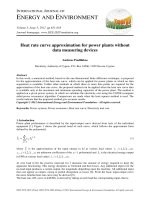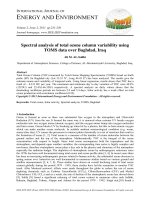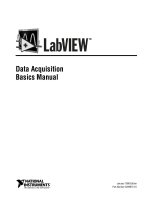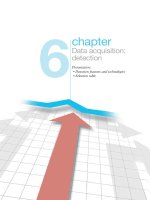DATA ACQUISITION
Bạn đang xem bản rút gọn của tài liệu. Xem và tải ngay bản đầy đủ của tài liệu tại đây (122.05 KB, 18 trang )
EXPERIMENT #7
DATA ACQUISITION
1/27/2010
Group:
DATA ACQUISITION
PURPOSE
The objectives of this laboratory are:
1. To examine signal sampling, aliasing and signal reconstruction.
2. To implement a time division multiplexing system.
3. To investigate the quantization error associated with analog-to-digital conversion.
EQUIPMENT LIST
1. PC with Matlab and Simulink.
LABORATORY PROCEDURE
I Sampling
A. The time division Multiplexer (TDM MUX) module is used to recombine two analog
signals into one data stream. The input A is connected to the OUT connector for a
period T (T = 1/fs). During the next period, input B is connected to the OUT
connector. The process then repeats. It should be obvious that each input, input A(or
B) is “Sampled” at a rate equal to ½ fs as set by the Master clock.
NOTE: The actual waveform sampling rate = ½ fs as set by the “DATA/Sampling
RATE”, output, mentioned above (e.g. to sample a 1kHz cosine, using this equipment
at the Nyquist rate then fs would have to be set to 4 kHz)
B. Next the fs were set to 10kHz and the function generator frequency was set to 1kHz.
The output signal OUT was observed on a scope and was also compared with the
input on a dual channel scope. The value of fs was slightly adjusted for a stable
display. The scope was moved to the sample-and-hold (S & H) output. We see that
the amplitude variations during the sampled period are now replaced with a constant
“flat top”.
Figure 7a – Sampling using Sample and Hold
The input signal looks like the one shown in figure below
Figure 7a input of the sampling using sample and hold method
Figure 7a Output of the Sample and hold circuit
t
The result when the input is overlapped with the output is what is shown below.
C. Next the function generator was connected to both the inputs A and B. at the OUT
connector of the TDM MUX, the generator’s signal appears undistorted. We see that after moving
the scope tot he S & H connector the signal is now being sampled at fs. (See figure 7B).
figure 7b(a) Time Division Multiplexing - Implementation
figure 7b (b)Time division Multiplexing – Input signal
figure 7b(c): Time division Multiplexing, Output
D. The output spectrum of the S & H output is observed. Values of f and fs are varied
and the effects of aliasing observed.
E. Effect of filtering: The sampled signal was reconstructed by feeding through a 4
th
order LPF to remove the aliasing frequencies.
II Time Division Multiplexing
A. Although multiplexing not classified as “data acquisition,” we shall make use of
TDM modules at this time. Two sine waves were prepared to be multiplexed by
setting the two VCO’s in open loop to 1 kHz and 2 kHz. Connect the 1 kHz sine
wave to the A input and 2 kHz since wave to the B input (see figure 7c). Set fs for
10kHz. The output OUT and S & H outputs in time and frequency domain were
observed. Yes, we can say that sampling frequency for the TDM system is fs/2. (i.e
half the time you sample A and half the time you sample B)
Figure 7c (a) Muxed signals
B. The S & H signal was connected to the TDM DEMUX. Internal timing connects the
TDM DEMUX input signal to the A output when the A input signal is selected by the MUX.
Similarly, the B output is connected to the DEMUX input when the MUX selects input B. Thus,
the TDM signal becomes “demultiplexed”. The Dual LPF was used to reconstruct the S & H
DEMUX output waveforms. All the waveforms observed are attached.
Figure 7c (a) Output of Signal 1 of TDM
Figure 7c(b) Implementation of 2 signal TDM









